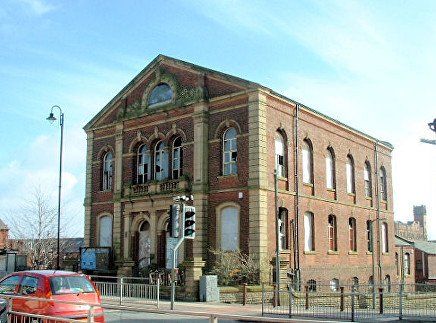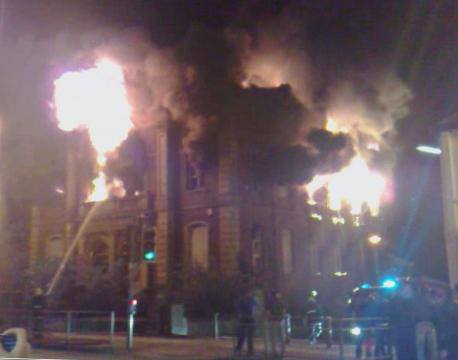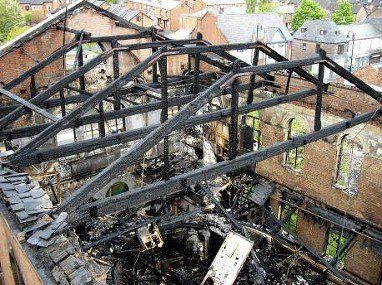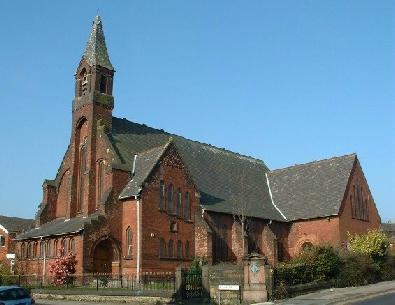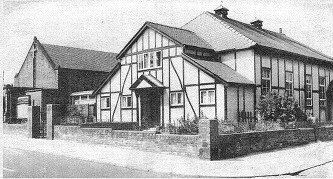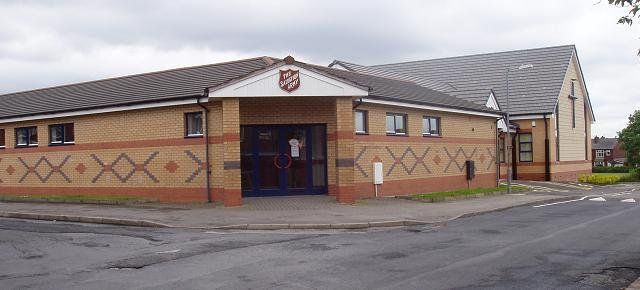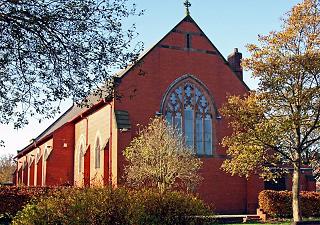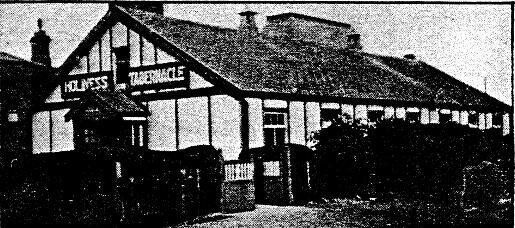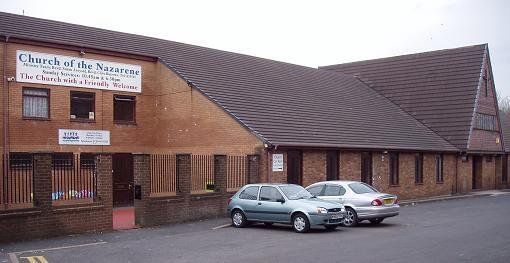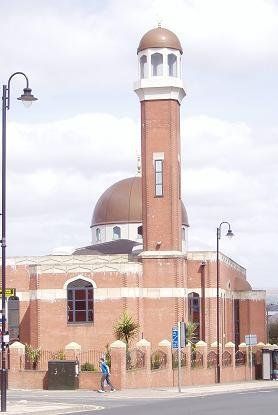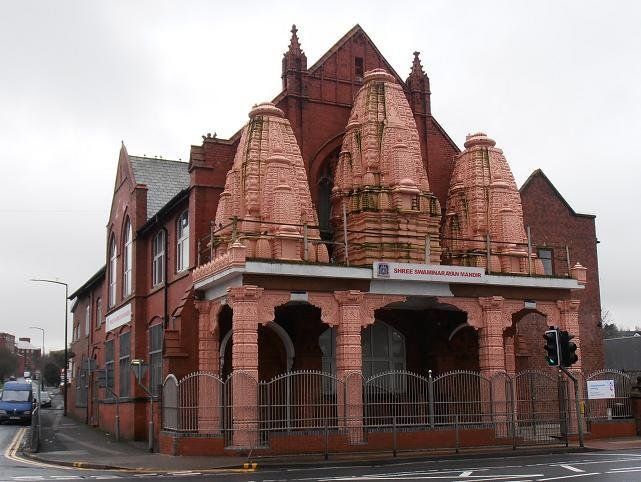Daubhill Methodist Church
In the 1850s Methodists from Fletcher Street began to hold cottage meetings at 65 St Helens Road, the home of one Abraham Birchall but as the cause grew so rapidly they hired a room in John Tonge’s School at the bottom of Barrier Street (Shed Lane), services starting there on 18th August 1858. Further growth led to the use of a boiler-house of a weaving shed owned by Messrs. W. and J. Cooke for the infant Sunday School Class. In 1861 a small chapel and school was built on land occupied by 47-51 St Helens Road. In 1868 the school was transferred to a new building in Stamford Street leaving 47-51 available for the building of a church which was finally opened in 1886 with a capacity for 700 worshippers.
(Bolton Journal and Guardian of Friday, 23 October 1936,reproduced in
http://www.lan-opc.org.uk/Bolton-le-Moors/Daubhill/methodist/index.html )
The Church was known to some as “Daubhill Wesleyans” and in the 1980s was renamed St Peter’s Methodist. The church closed its doors in 2001 and was for some years derelict, a number of plans for its use including housing and conversion to a hotel being proposed and shelved. Arson attacks on 15th and 29th October 2003 caused considerable damage; a further attack on 3rd May 2009 left it gutted and in a dangerous state and it was demolished on the 7th May the site still remaining empty at the present time (July 2013) (and still empty September 2021).
The two pictures below were posted on the Facebook group "Daubhill" by Barry Stanton.
St George the Martyr’s Church of England, Church Avenue started as a church and school in an iron building. Construction of the present church began in 1878 and it was consecrated 6th March 1880. Interior changes were made in 1976 and 1988.
On Sunday afternoons it welcomed the Living Waters Malawian Church but this was discontinued in 2012 with two of its families joining the SGM fellowship.
SGM is not named after the patron saint of England, but after George Marsh (1515-1555) whose footprint is said to be preserved in a flagstone in Smithills Hall. After refusing to recant his Protestantism he was tried at Lancaster and Chester and burnt at the stake at Boughton near Chester.
Part of the West Bolton Team of Churches www.facebook.com/SGMbolton
Daubhill Zion Methodist Church was probably built around 1880. It was closed in the 1950s (early 1960s?) and demolished to make way for a small supermarket, W&G (Winnick and Giles) later Spar and at present McColl's.
Melbourne Rd Methodist Church began as a temporary though quite substantial structure (the nearer building on the picture) around 1930 (one of at least three church buildings in that style). Children of the 1950s remember magic lantern shows and pie and peas. The present church was built around 1960 and the original building was retained for many years for social activities including the monthly meeting for senior citizens, then being sold to a sports club and later replaced by housing around 1990.
The church closed in 2019 and its congregation amalgamated with Saint Helens Road Methodist Church. The main reason for closure of quite a strong church was the ongoing vandalism of the building and the associated costs which were not sustainable.
During the months of April, May and June hardly a Sunday went by without the sounds of a band and the sight of a procession. Every Sunday School held its Annual Sermons Day and walked through the streets, the band leading, sometimes the church's own band, more usually the Salvation Army band, followed by the "little singers", girls in white dresses and boys in short trousers and white shirts, then the Sunday School classes with their teachers, the ladies and young couples and lastly the men. The procession would stop on various street corners where a hymn would be sung, a Bible verse read and an invitation issued to the Special Services.
St Helens Road Methodist Church - The first phase was opened on 2nd March 1899, with the 'Lower School' and the ‘Chapel School’ opened on 25th March 1903. The house next door which appears to have been the manse for the church when it first opened has the date 1901 on its down-spouts.
The congregation of Melbourne Road Church joined with SHR in 2019.
Minister: Rev Caroline Lawrence
http://www.shrmethodist.org.uk
Haynes St Mission is seen on the 1910 map. It was originally a mission church from St Bede's. When the parent church decided to close it the congregation wanted to retain its independence and moved to a wooden building on Aldred Street. The original premises were then used by a sewing firm. The minister at Haynes Street Mission for many years was a Rev Povey a former coal miner. It saw a dwindling congregation over many years and closed down when the Salvation Army Daubhill Corps moved into the premises from its Bella Street building in ??1990.
The Salvation Army had a very strong Corps at Bella Street from early in the twentieth Century. It had fallen on hard times by about 1990(?) and joined forces with Haynes Street Mission, moving into their Aldred Street building but remaining Salvation Army and winding up the Haynes Street Mission work. The Bella Street building remains and is used by a sound and lighting firm.
The Daubhill, now Bolton South, Corps of the Salvation Army then flourished under the leadership of the dynamic Captain Darren Cox to such an extent that the hall was rebuilt in 2000?? and then a completely new, larger sanctuary was built alongside it which was opened in 2012. The previous meeting hall is now used for community work. Capt Cox married an Australian girl and after two or three years moved with her to Australia. The Corps was then ably led by Capt Janis Lahouel who moved to Burkina Faso in 2021.
The top picture shows the 2000 building, the lower picture shows the 2012 building with the 2000 building at the left side of the picture.
St Bedes Church of England – Before 1915 Morris Green was part of the parish of St George the Martyr.
By 1915 Morris Green had become a conventional district with a Curate In Charge and it was the aim of the people to have their own church. The 1914-1918 war affected their efforts to raise money to build the church but some of the older residents remember making raffia photograph frames with a picture imprinted on them. The people were persuaded to pay 6d to buy a brick and the Young Men’s class and Sunday School played their part in raising funds towards building the church.
Church of the Nazarene - Revival came to Daubhill in Summer 1931 with the arrival of a rather special group of "Cliff College Trekkers" to hold open air meetings outside Tootall's mill as the spinners arrived in the morning and to set up a tent on the disused market site in Daubhill. Unusually, this group of trekkers all belonged to the same denomination, the International Holiness Mission (IHM).
The ground had been laid by holiness believers from Westhoughton (members of a fellowship resulting from a trek of two years previously) distributing literature. But such was the power of the preaching and the overwhelming movement of the Holy Spirit that the tent in which they had began their meetings soon proved to be too small and a larger one had to be obtained. The Daubhill Church was formally established as a Mission Church of the IHM on 11th July 1931, still in the tent. A permanent building was envisaged and Albert Lown (one of the trekkers, later Rev Dr A Lown and the fourth minister) spent hours in a house in Southend Street drawing up plans. The resulting building, "The Holiness Tabernacle" known to two generations as "the tab" was opened on 31st November of the same year.
Before the second world war the church grew numerically and spiritually and the Sunday School, choir and other groups were set up. The war years depleted the congregation and times were hard but the Daubhill church kept in its prayers the needs of lost souls at home and abroad and reflected this in their giving, faithfully supporting a work on the Mission Field in Africa.
In 1952, the most crucial change since 1931 took place when the IHM and the Church of the Nazarene in the British Isles joined with the worldwide Church of the Nazarene (at that time chiefly in USA and Canada but with a missionary presence in many other countries). The Union was formally ratified on 29th October, 1952 with the Calvary Holiness Church (CHC) joining this denomination slightly later. The Holiness Tabernacle at Daubhill became the Bolton first (or Daubhill) Church of the Nazarene though for many years after most people still knew it as the Tabernacle.
Missionary interest was enhanced in 1953 when an independent missionary to Thailand, Lilian Hamer, took the Nazarene church at Daubhill as her home base. She was supported by prayer and giving until her untimely death in her beloved Thailand in 1959. She was remembered in the naming of an old people’s home on Deane Road where for many years a board displayed newspaper cuttings of some of her activities and a report of her murder.
A small extension was built in 1953 but sacrificial giving over the next decade saw that building removed and the present sanctuary opened in 1963. The “tabernacle” was retained for the Sunday School and use by the youth and the uniformed organisations. The lounge and kitchen were added in 1975 then in 1984 the “tabernacle” was finally demolished to make way for the Sunday School Hall and education area.
In 2008/9 the sanctuary was updated with new lights, carpet and chairs. In 2011 the kitchen was renovated.
The church now has a congregation of 50-60 adults most Sunday mornings with 20 plus children in “The Island”. There are meetings for the younger girls (Gems) and younger boys (Explorers) and Connect for the teenagers. There are a number of house groups and “clubs” - Book Club - Chats and Crafts - and a regular weekday fellowship meeting for the more senior people. We have a well regarded choir with an excellent Junior Choir being trained for Sermons and Christmas. Our cafe opens 10.30am-2.00pm each Friday for morning coffee and light lunches and is open to all.
HOWEVER much of the above activity had to be suspended during the COVID pandemic of 2020 and in September 2021 discussions are ongoing as to what activities will be restarted and when. Gems and Explorers have been meeting together as Nazarene Allsorts since the return to school and the Island has also recommenced.
The Kindergarten established in 1976 caters five days a week for pre-school children and has a well deserved excellent reputation.
http://church-of-the-nazarene-bolton.webeden.co.uk which because of forces outside out control will change before December 2021
New Testament Church of God, 10 Church Avenue - no information - ntcgbolton@btconnect.com is faulty
Immediately outside the strict Daubhill area we find
the Mount St Joseph convent on Willows Lane, now closed down and the building used as a Moslem college. This was also Mount St Joseph Catholic School which has now moved to Minerva Road near Royal Bolton Hospital.
St Ethelbert's Roman Catholic Church is down the hill from here on Hawthorn Road
The ancient parish church of St Mary's, Deane is just off Wigan Road opposite Deane Church Lane
St Philip's, Great Lever is on Bridgeman Street at the bottom of Swan Lane
Noble Street Independent Methodist Church is off the bottom of Derby Street.
St Andrews CoE, Over Hulton, at Four Lane Ends
St Vincent de Paul RC Church, New Brook Road
Kingdom Hall of Jehovah's Witnesses, Noble Street off Derby Street.
Note on "Sermons"
Churches in many areas hold such special days and processions, often called "Whit Walks" but the term "Sermons" seems to be local to parts of Northern England and not understood by people from elsewhere. "Sermons Sunday? In our church we have sermons every Sunday!"
When Robert Raikes and others first established "Sunday Schools" they were not Bible Classes but places where unruly youngsters could be taken off the streets and taught to read and write and do simple sums. Remember, in those days education was only for the rich and privileged. The mill-owners were not enthusiastic about having an educated work force who might get ideas above their station and perhaps even read about thing like Socialism! So RR paid "worthy women" one shilling each Sunday to teach the three Rs. But once each year, a special meeting would be held at which achievements would be recognised and prizes given, and the local vicar would be invited to address the teachers and pupils and preach a sermon. This was "Sermons Day".
The Sunday Schools in Daubhill came later and were all established by the churches for Bible teaching, but the term "Sermons Day" was retained for the Sunday School Anniversary.
In Bolton there are (?) 34 mosques and Islamic institutions (the muslimsinbritain web-site lists 22).
Ar-Rahman Masjid Islamic Cultural Centre and Zakaria Mosque
20 Peace Street, Bolton, Lancashire, BL3 5LJ
Probably the biggest mosque in Bolton. Accommodates 1400 people including women (pictured right)
Al-Jamiah Al-Islamiyah
Also known as Darul Uloom Lancs, Al-Jamiatul Islamiyah Darul Uloom
Former St Joseph's Convent. Mount St Joseph's Convent, Willows Lane, Deane, Bolton, Lancashire, BL3 4HE
Masjid-e-Ghosia
rear of 81-83 Auburn Street, Bolton, Lancashire, BL3 6UE. Former St Paul's Mill, Caroline Street.
Masjid al Aleef
Also known as: Masjid-e-Aleef, Great Lever Muslim Society, Sunny Side Welfare Trust
8 Higher Swan Lane, Bolton, Lancashire, BL3 3AJ
Daubhill Islamic Society, Daubhill Muslim Society, Rahmania Primary School (Islamia Nursery) 2-14 Randal Street, Daubhill, Bolton, Lancashire, BL3 4AE
Ashrafia Mosque
Cannon Street North, Deane, Bolton, Lancashire, BL3 5DN
Dar ul Qur'an Masjid
458 Bridgeman Street, Bolton, Lancashire, BL3 6TH
Masjid-e-Noor
329 St Helens Road, Bolton, Lancashire, BL3 3QD
The muslimsinbritain web site points to a grocers shop on the corner of Aldred St and St Helens Road but I presume that what is intended is the “Education Centre” on the opposite corner in the old Middle Hulton Police Station.
=====
There are many more mosques in the east side of Bolton
The next page describes living up Dobble, 1940s onward

